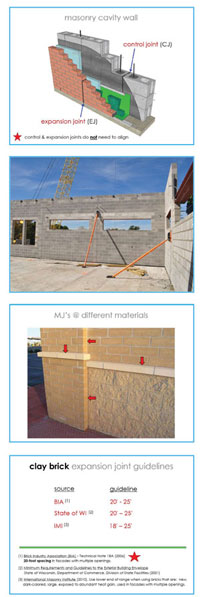Date: January 10, 2019 | Time: 5:00pm-6:00pm - 1 AIA Health, Safety, Welfare (HSW) Credit
BEC-GD January 2019 Joint Program with CSI: Masonry Movement Joints
The national model masonry code requires building designers to “indicate type and location of movement joints on the project drawings.” Additionally, the veneer section of the code requires building designers to “design and detail the veneer to accommodate differential movement.”
 Do you know the key differences between a CJ, EJ, IJ, BEJ? This seminar will teach you how to locate movement joints to accommodate or restrain building and material movement to avoid cracks or system failures. You will learn about control and expansion joints at corners, shelf angles, top-of-wall bond beams, loose & fixed lintels, cement-based veneers, load-bearing CMU walls, stair towers, and adhered veneers. You will also learn how to select proper sealant color.
Do you know the key differences between a CJ, EJ, IJ, BEJ? This seminar will teach you how to locate movement joints to accommodate or restrain building and material movement to avoid cracks or system failures. You will learn about control and expansion joints at corners, shelf angles, top-of-wall bond beams, loose & fixed lintels, cement-based veneers, load-bearing CMU walls, stair towers, and adhered veneers. You will also learn how to select proper sealant color.
Seminar Objectives
1) Learn masonry movement joint definitions.
2) Discover movement characteristics of different masonry materials.
3) Understand the purpose of movement joints and where to put them.
4) Acquire knowledge to design and detail both vertical and horizontal movement control strategies.
Seminar Duration: 1.0 Hour
AIA Credit: 1.0 LU / HSW
AIA Provider Name: International Masonry Institute
AIA Provider #: G390
AIA Program #: 1MMJ101
Cost: $5 at door
 Speaker Info
Speaker Info
Jeff Diqui
International Masonry Institute Director, Technical Services jdiqui@imiweb.org 630.606.8220
Mr. Diqui, holds a Bachelor of Science Degree in Architectural Engineering with a major in Structural Engineering from Milwaukee School of Engineering. He has more than 25 years of experience that has been focused on the building enclosure. Experience has included forensic investigations related to moisture intrusion and structural related problems, structural design, building condition assessments, development of repair / rehabilitation designs, and construction observations. For over a decade, Jeff has been a frequent lecturer nationally to architects, engineers, specifiers, building envelope consultants, contractors, and code officials on subject matter pertaining to the importance of maintaining continuity of air, water, vapor, and thermal controls of the enclosure and the ever-important interface detail. Jeff is actively involved with the building science and architectural / engineering professions. He is Program Director for the Building Enclosure Council (BEC) – Chicago Chapter, Technical Roundtable Committee Member of the Construction Specifications Institute (CSI) – Chicago Chapter, and Terminations & Flashings Committee Member of the Air Barrier Association of America (ABAA).
This program is co-hosted by the Metro Detroit Construction Specification Institute
